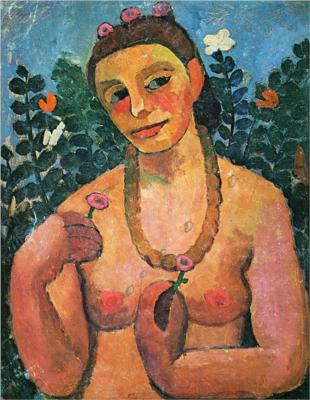Paula Becker was born in Dresden in 1876, Germany, the third of seven children. Her father was employed by the German railway. Her mother was from an aristocratic family. The Beckers provided their children a cultured and intellectual home environment and encouraged Paula's artistic gifts. When Paula was about 12, in 1888, the Becker family moved to Bremen.
When Paula was 16, she lived in London with an aunt for 6 months while she studied drawing at a professional art school.
Her parents wanted her to have a secure way of supporting herself, so Paula completed a teacher's training program, and then, between 1896 and 1898, she studied at the Berlin School for Women artists.
In order to continue her art education under painter Fritz Mackensen, Paula joined the artists' colony in Worpswede, near Bremen, that he had founded with Otto Modersohn and others. She and two other women had their own studios in the colony.
The painters of Worpswede believed in and promoted a romanticized view of country life. Paula however rejected their sentimental approach, believing that spiritual values could be represented better through realistic treatment of the subject. She completed some rather bleak landscapes, but her greater strength was in depicting the women and children of the farming community around the town with a sort of rough simplicity.
While she was at Worpswede, Paula developed a friendship with one of its founders, artist Otto Modersohn, and his wife, Helene. She also developed a close intellectual friendship with the poet Rainer Maria Rilke and his wife, sculptor Clara Westhoff.
Paula knew that Paris was the center of developing trends in art, and she moved there in 1900, to join an art academy and to haunt the museums and galleries, where she found inspiration in the works of Cézanne, Gauguin, and van Gogh.
Later in the year, she invited Otto and Helene to come to Paris to view the World Fair. Otto went to Paris but Helene was unable to travel because she was suffering from tuberculosis. In fact, she died while he was gone. Otto returned to Worpswede to look after his one-year-old daughter.
Paula's sense of responsibility soon drew her back to Worpswede to help care for Helene's baby, and by 1901, Paula and Otto were married; she was 25. Multiple sources describe their relationship as "unconsummated" for several years; although that seems strange, Paula frequently said that she wanted to postpone motherhood until her career was established.
 |
| Paula Modersohn-Becker and Elsbeth Modersohn in Worpswede, 1903 |
For the next 6 years, Paula pursued her career, alternating between Worpswede and Paris. However much she might have liked to make her home in the art capitol of the world, she was economically dependent on Otto, as well as being emotionally attached to him and his daughter.
She was very productive, creating hundreds of paintings and drawings.
One of the things Paula was famous for was depicting nude women. This was a popular subject for men, of course, but their images tended to be sexualized and romanticized. Paula depicted naked women in a coarser, more confrontational way. She is generally credited as the first woman to paint nude self-portraits. This was in the first decade of the 20th century when it was considered outlandish for women to paint nudes, let alone themselves without clothes.
Paula is notable for her painting technique. Her paintings show flat, massive figures dominating their surroundings. Tempera was her favorite medium and she deliberately roughed up the surface by scratching into wet paint.

As she approached 30, Paula became increasingly drawn to the idea of having her own child, and to idealize motherhood in her painting and her correspondence.
Paula expressed both the desire to be a mother and the desire to be a bold artist by painting two nude portraits of herself pregnant — before she was actually expecting. These paintings are considered the first of their kind.
Paula and Otto spent the winter together in Paris, and Paula became pregnant, so she agreed to return with him to Worpswede the following spring. Their daughter, Mathilde, was born in November, 1907. A few weeks later, Paula died of a heart attack caused by an embolism, brought on by extended bed rest, as was the custom at the time. She was 31.
During her lifetime, Paula's work was both ridiculed and praised, but was also largely overshadowed by that of her husband, Otto Modersohn.
The Paula Modersohn-Becker Museum in Bremen is the first museum dedicated to a woman artist. It opened in 1927.
My Photos of Paula's Work:
 |
| Girl with Child, c. 1904 Gementemuseum / Jan's photo. 2015 |
 |
| Two Girls in Front of Birch Trees, c. 1905 St. Louis / Jan's photo, 2013 |
 |
| Self-portrait with Hat and Veil, 1906 Gementemusuem / Jan's photo, 2015 |
Internet example of Modersohn's work:
 |
| Otto Modersohn, 1865-1943 Inundation, undated Internet |
Internet examples of Paula's work:
 |
| Jeune Fille Tenant des Fleurs Jaunes dans un Verre, 1902 Tempera on cardboard / 21" square Bremen / Internet |
 |
| Old Peasant Woman, 1905 Detroit / Internet |
 |
| Paula Modersohn-Becker Reclining Female Nude, 1905-1906 |
 |
| Self-portrait with amber beads, 1906 |
 |
| Sixth Wedding Anniversay, 1906 |
 |
| Reclining Mother and Child II, 1906 |




